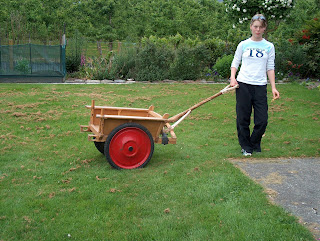Wagons
 A wagon made by an artist
A wagon made by an artistRight, boys and girls, I'm making a wagon. What d'you mean, why? Since when did why? figure in our discussions? Because I like making wagons, that's why, and it's a jolly fine reason. I do not need a wagon; I already have one. Well the children do, and even now they're grown up they still play on it, scooting up and down the road to the annoyance of the neighbours who think we're irresponsible parents in which matter they're entirely correct.
As a matter of fact I am genetically disposed to make wagons; it is in my blood. I had an ancestor who edited The Coach Builders’, Harness Makers’ and Saddlers’ Art Journal - a snappy little title - of which I have seen this many copies: 0. But I know it's genetic because my brother made a wagon and he's an engineer and never normally makes anything without a motor and wagons don't have motors. He couldn't help himself. He went innocently to bed one night and suddenly came to in his workshop and there was a wagon he'd just built.
 A wagon made by an engineer
A wagon made by an engineerThe purpose of a wagon is to look pretty. Engineers all want it to be functional but this is nonsense. All wagons are functional and the chief function is prettiness and my wagon is so pretty that passers-by stop and ask me if I made it and then call me brilliant, which I need to hear since Kaye next door seldom does. She calls me Ruptured instead. 'Hello, Ruptured,' she says when we find ourselves simultaneously emptying the bins. At least, I think this is what she says; it might just be the famous New Zealand Vowel Shift which all the linguists are presently writing their PhDs on. We like the New Zealand Vowel Shift. The local schoolchildren all try to make you say Six and when you do they giggle furiously. My wife has had to learn to say Six because otherwise the patients don't understand her. They really don't. 'When did you last have Six?' she sometimes has to ask, mostly of the high school girls. Otherwise they think she's talking about Sacks, and get very confused.
The new wagon is the result of a felled willow tree given to us for free firewood, but I happen to know that wagon floorboards were willow because it's tough and doesn't splinter, so it got turned into wagon planks instead. Each plank is 19.05 mm thick because I eschew Imperial measurements, and it's as wide as I could get it. The game is to saw thick, and plane thin after a summer's seasoning. Planer-thicknessers are little troubled by willow, which is light and fluffy. I imagine willow won't last 20 years but oak firewood is scarce in Motueka. Does linseed oil preserve cricket bats for longer? Anyway willow is light, and the children's oak wagon is surprisingly heavy even though the planks are a mere 12.7 mm thick.
Now, a word about words because the dictionaries don't agree with one another. A wagon has four wheels and a cart has two and if you don't agree then I'll fight you. And I'll fight you if you call it a trolley like that rat-faced bloke in Beacon Cycles once did, because it isn't low and trolleys have to be low. Wagons aren't low. And anyway a trolley sounds like a thing on platform 4 of March Station, and my wagon is très elegant. I forget why I went into Beacon Cycles, but he was disparaging about my wagon and he was disparaging about my recumbent and he had a face like a rodent, except for the ears. He was ugly in a different way from Rhodes Boyson but I'm not choosy. I'd like to have had him shot just the same.

A cart, having two wheels. And a daughter, having a biscuit

0 Comments:
Post a Comment
Subscribe to Post Comments [Atom]
<< Home